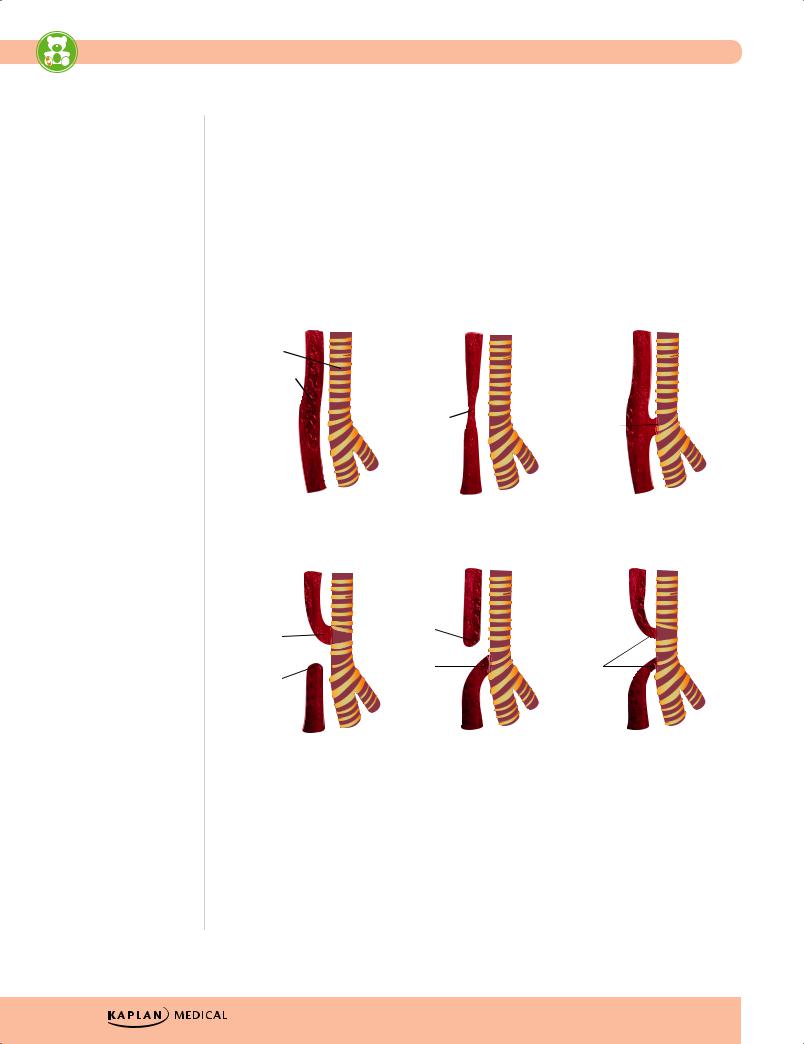
Полезные материалы за все 6 курсов / Учебники, методички, pdf / Kaplan Pediatrics USMLE 2CK 2021
.pdf
USMLE Step 2 CK λ Pediatrics
•Diagnosis
−Inability to pass nasogastric/orogastric tube
−Esophageal atresia: x-ray shows coiled nasogastric tube in blind pouch with no distal gas (gasless abdomen)
−Isolated TEF: esophagram with contrast media (or bronchoscopy or endoscopy with methylene blue)
–Esophageal atresia and distal fistula: coiled nasogastric tube in blind pouch the large amount of air in stomach and intestines
•Treatment—surgical ligation of TEF and resection with end-to-end anastomosis of esophageal atresia
Normal Anatomy |
Atresia (9%) |
Fistula (6%) |
Trachea
Esophagus
Atresia |
Fistula |
|
Atresia with Proximal |
Atresia with Distal |
Atresia with Double |
Fistula (1%) |
Fistula (82%) |
Fistula (2%) |
Fistula |
Atresia |
|
|
|
|
Atresia |
Fistula |
Fistula |
|
|
Figure 14-1. Tracheoesophageal Fistula (TEF) Types
144

Chapter 14 λ Gastrointestinal Disease
Gastroesophageal Reflux Disease (GERD)
A 4-month-old is admitted with episodes of apnea occurring 20–30 min after feeds. The mother states the baby has been spitting up since birth. She is at the 5th percentile for weight.
Almost all infants have some degree of reflux (mild to moderate) from birth due to slow development of lower gastroesophageal sphincter tone development. Improvement is seen over the first months and almost always resolves by age 12-24 months. Older children are clinically like adults; only about 50% spontaneously resolve.
Most cases present as postprandial regurgitation, significantly fewer as esophagitis or recurrent aspiration. Clinical findings usually raise suspicion of this diagnosis; barium esophagram determines if recurrent aspiration is due to GERD or TE fistula. The best test (which is also quantitative) is an in-hospital overnight pH study. Endoscopy is used for presumptive reflux esophagitis.
Treatment is mostly conservative, with the addition of H2 blockers or PPI for severe cases and esophagitis. Fundoplication is used for refractive disease.
Pyloric Stenosis
A 4-week-old boy has nonbilious projectile vomiting. Physical examination is remarkable for a small mass palpated in the abdomen.
•Epidemiology—more common in whites of Northern European ancestry, firstborn males
•Clinical presentation
−Nonbilious, projectile vomiting
−Still hungry and desire to feed more
−Usually age ≥3 weeks (1 week to 5 months)
−Mild-to-moderate dehydration, hypochloremic, hypokalemic metabolic alkalosis
−Palpation of a firm, movable, 2-cm, olive-shaped, hard mass in midepigastrium; left to right peristaltic wave
•Diagnosis—best test is ultrasound (a target-like appearance in cross-section)
•Treatment
−Rehydrate, correct electrolytes (NaCl, KCl)
−Pyloromyotomy
Note
Pyloric stenosis is high yield for the exam.
Published by dr-notes.com |
145 |
|
|
|
|

USMLE Step 2 CK λ Pediatrics
Note
Jejunal or Ileal Atresia
•Often presents on day 1 of life
•Bile-stained emesis with abdominal distention (unlike duodenal atresia, which has no abdominal distention)
Plain x-ray shows air-fluid level
•Contrast study of upper/ lower intestine highlight level of obstruction
•U/S may differentiate intestinal atresia from meconium ileus from malrotation
Duodenal Atresia
A newborn presents with bilious vomiting with every feed. Abdominal film reveals a double bubble.
•Epidemiology
−Half are born premature
−Down syndrome
−With other anomalies—malrotation, esophageal atresia, congenital heart defects, anorectal malformation, renal anomalies
•Clinical presentation
−Bilious vomiting without abdominal distention on first day of life (obstruction just distal to ampulla)
−Polyhydramnios prenatally
−Many with jaundice (increased enterohepatic circulation)
•Diagnosis
−X-ray shows classic double bubble with no distal bowel gas.
−X-ray spine for anomalies; ultrasound for other anomalies
•Treatment
−Nasogastric decompression
−Intravenous fluids
−Surgery—duodenoduodenostomy
Clinical Recall
A newborn is diagnosed with a tracheoesophageal fistula. What additional anomaly is she most likely to have?
A.Pulmonary stenosis
B.Sternal dysplasia
C.Oral atresia
D.Renal agenesis
E.Ectopia lentis
Answer: D
146

Chapter 14 λ Gastrointestinal Disease
Table 14-4. Congenital Bowel Obstruction
|
|
|
|
|
|
|
|
|
|
Clinical |
|
|
|
|
|
Management |
|
|
|
|
|
|
|
|
|
|
|
Background/ |
|
|
|
|
|
Algorithm/Definitive |
|
|
|
|
|
|
|
|
|
|
|
|
|
||||||
|
Lesion |
|
|
Etiology |
|
|
DDX |
|
Presentation |
|
Diagnosis |
|
|
Treatment |
|||
|
|
|
|
|
|
|
|
|
|
|
|
|
|
|
|
|
|
|
Duodenal |
|
Failed recanaliza- |
|
• Duodenal |
• Polyhydramnios |
|
• Prenatal |
|
• NG/OG decompres- |
|||||||
|
Atresia |
|
tion of bowel |
|
stenosis |
• 50% premature |
|
sonogram |
|
sion |
|||||||
|
|
|
|
lumen 4th–7th |
|
|
|
|
|
|
|
|
|
||||
|
|
|
|
|
• Annular |
• Other organ |
|
• Postnatal plain |
|
• NPO + IV fluids + |
|||||||
|
|
|
|
week gestation |
|
|
|
||||||||||
|
|
|
|
|
pancreas |
|
x-ray: double- |
|
electrolyte balance |
||||||||
|
|
|
|
|
|
system anoma- |
|
|
|||||||||
|
|
|
|
|
|
|
|
|
|
||||||||
|
|
|
|
|
|
|
|
|
|
|
bubble with NO |
|
|
|
|||
|
|
|
|
|
|
|
• Duplication |
|
lies |
|
|
• Broad-spectrum |
|||||
|
|
|
|
|
|
|
|
|
distal bowel gas |
|
|||||||
|
|
|
|
|
|
|
cysts |
• Half with |
|
|
antibiotics |
||||||
|
|
|
|
|
|
|
|
|
|
|
|||||||
|
|
|
|
|
|
|
|
|
|
• CXR, spine films |
|
|
|
||||
|
|
|
|
|
|
|
• Ladd bands |
|
chromosomal |
|
|
Definitive Treatment: |
|||||
|
|
|
|
|
|
|
|
|
• Echocardiogram |
|
|||||||
|
|
|
|
|
|
|
from malrota- |
|
anomalies, |
|
|
Surgery when |
|||||
|
|
|
|
|
|
|
tion |
|
especially |
|
|
|
|
||||
|
|
|
|
|
|
|
|
|
• Renal ultrasound |
|
stable— duodenoduo- |
||||||
|
|
|
|
|
|
|
|
|
|
trisomy 21 |
|
for other most |
|
denostomy |
|||
|
|
|
|
|
|
|
|
|
|
|
|
|
|
|
|
||
|
|
|
|
|
|
|
|
|
Presentation |
|
common |
|
|
|
|||
|
|
|
|
|
|
|
|
|
• First day |
|
anomalies |
|
|
|
|||
|
|
|
|
|
|
|
|
|
|
|
|
|
|
|
|||
|
|
|
|
|
|
|
|
|
• Bilious vomiting |
|
|
|
|
|
|
||
|
|
|
|
|
|
|
|
|
|
w/o abdominal |
|
|
|
|
|
|
|
|
|
|
|
|
|
|
|
|
|
distention |
|
|
|
|
|
|
|
|
|
|
|
|
|
|
|
|
• Jaundice |
|
|
|
|
|
|
||
|
|
|
|
|
|
|
|
|
|
|
|
|
|
|
|
|
|
|
Jejunal and |
|
Intrauterine |
|
• Meconium |
• Possible role with |
|
• Less likely to be |
|
• NG/OG |
|||||||
|
Ileal Atresias |
|
vascular accident |
|
ileus/plug |
|
antenatal |
|
detected in utero |
|
• IV fluid and electro- |
||||||
|
|
|
|
→ segmental |
|
|
|
|
cigarette and/or |
|
|
|
|
||||
|
|
|
|
|
• Malrotation + |
|
|
• Plain x-ray: |
|
lyte balance prior to |
|||||||
|
|
|
|
infarction and |
|
|
cocaine use |
|
|
||||||||
|
|
|
|
|
volvulus |
|
|
multiple air-fluid |
|
surgery |
|||||||
|
|
|
|
resorption of |
|
|
|
|
|
|
|||||||
|
|
|
|
|
• Hirschsprung |
• Very little familial |
|
levels proximal |
|
• Antibiotics |
|||||||
|
|
|
|
fetal intestine |
|
|
|
||||||||||
|
|
|
|
|
|
inheritance (aut. |
|
to obstruction in |
|
||||||||
|
|
|
|
|
disease |
|
|
|
|
|
|||||||
|
|
|
|
|
|
|
|
|
|
Definitive Treatment: |
|||||||
|
|
|
|
|
|
|
|
rec.) |
|
upright or lateral |
|
||||||
|
|
|
|
|
|
|
|
|
|
|
|
||||||
|
|
|
|
|
|
|
|
|
• Little extraintesti- |
|
decubitus |
|
Surgery—resect dilated |
||||
|
|
|
|
|
|
|
|
|
|
|
|
|
proximal bowel, then |
||||
|
|
|
|
|
|
|
|
|
|
nal anomalies |
|
• Ultrasound: |
|
||||
|
|
|
|
|
|
|
|
|
|
|
|
end-to-end |
|||||
|
|
|
|
|
|
|
|
|
|
|
|
|
differentiate with |
|
|||
|
|
|
|
|
|
|
|
|
Presentation |
|
|
anastomosis |
|||||
|
|
|
|
|
|
|
|
|
|
meconium ileus |
|
|
|
||||
|
|
|
|
|
|
|
|
|
• Polyhydramnios |
|
|
|
|
||||
|
|
|
|
|
|
|
|
|
|
and identify |
|
|
|
||||
|
|
|
|
|
|
|
|
|
• Abdominal |
|
malrotation |
|
|
|
|||
|
|
|
|
|
|
|
|
|
|
distention at |
|
• Contrast studies |
|
|
|
||
|
|
|
|
|
|
|
|
|
|
birth or with first |
|
to localize |
|
|
|
||
|
|
|
|
|
|
|
|
|
|
feeds + vomiting, |
|
|
|
|
|
|
|
|
|
|
|
|
|
|
|
|
|
may be bilious |
|
|
|
|
|
|
|
|
|
|
|
|
|
|
|
|
• Few with delayed |
|
|
|
|
|
|
||
|
|
|
|
|
|
|
|
|
|
or no passage of |
|
|
|
|
|
|
|
|
|
|
|
|
|
|
|
|
|
meconium |
|
|
|
|
|
|
|
|
|
|
|
|
|
|
|
|
• Jaundice |
|
|
|
|
|
|
||
|
|
|
|
|
|
|
|
|
|
|
|
|
|
|
|
|
|
|
|
|
|
|
|
|
|
|
|
|
|
|
|
|
|
(Continued) |
|
Published by dr-notes.com |
147 |
|
|
|
|

USMLE Step 2 CK λ |
Pediatrics |
|
|
|
||
Table 14-4. Congenital Bowel Obstruction (Cont’d) |
|
|
|
|||
|
|
|
|
|
|
|
|
|
|
|
|
|
Management |
|
|
|
|
Clinical |
|
Algorithm/ |
|
|
|
|
Background/ |
|
Definitive |
Lesion |
Etiology |
|
DDX |
Presentation |
Diagnosis |
Treatment |
|
|
|
|
|
|
|
Meconium |
Abnormal |
|
• Meconium |
• 80-90% will be |
• Plain films: |
• NPO |
Ileus |
viscous |
|
plug |
diagnosed with |
dilated loops of |
• NG/OG |
|
secretions → |
|
• Atresias |
CF |
bowel proximal |
decompression |
|
distal 20-30 cm |
|
||||
|
|
• Hirschsprung |
• May perforate in |
to obstruction |
• IV fluid and |
|
|
of ileum |
|
||||
|
collapsed and |
|
disease |
utero → |
that vary with |
electrolyte balance |
|
proximal bowel |
|
• Malrotation + |
meconium |
width and not |
• Antibiotics |
|
dilated and filled |
|
peritonitis |
evenly filled |
||
|
|
volvulus |
Definitive Treatment: |
|||
|
with thick |
|
(calcifications) |
with gas |
||
|
|
|
First: hypertonic |
|||
|
meconium |
|
|
Presentation: |
• Presence of |
|
|
impacted in |
|
|
water-soluble contrast |
||
|
|
|
|
bubbly or |
||
|
ileum |
|
|
• Vomiting |
enema to attempt |
|
|
|
|
granular |
|||
|
|
|
|
becomes |
wash-out |
|
|
|
|
|
persistent with |
appearance in |
If fails—laparotomy |
|
|
|
|
prominent |
RLQ (meconium |
|
|
|
|
|
with gas |
|
|
|
|
|
|
abdominal |
|
|
|
|
|
|
bubbles) |
|
|
|
|
|
|
distention |
|
|
|
|
|
|
• No air-fluid |
|
|
|
|
|
|
• No passage of |
|
|
|
|
|
|
levels as |
|
|
|
|
|
|
meconium |
|
|
|
|
|
|
secretions are |
|
|
|
|
|
|
• May present as |
|
|
|
|
|
|
too viscid to |
|
|
|
|
|
|
bowel |
|
|
|
|
|
|
layer |
|
|
|
|
|
|
perforation and |
|
|
|
|
|
|
• Ultrasound to |
|
|
|
|
|
|
peritonitis |
|
|
|
|
|
|
verify if |
|
|
|
|
|
|
• Palpation of |
|
|
|
|
|
|
questionable |
|
|
|
|
|
|
“doughy” or |
|
|
|
|
|
|
• Water-soluble |
|
|
|
|
|
|
cordlike masses |
|
|
|
|
|
|
enema |
|
|
|
|
|
|
|
|
|
|
|
|
|
|
(Gastrografin or |
|
|
|
|
|
|
Hypaque) will |
|
|
|
|
|
|
localize |
|
|
|
|
|
|
• Test for CF |
|
|
|
|
|
|
|
|
Meconium |
Decreased water |
|
• Meconium ileus |
• Majority not |
• Plain films: low |
• NG/OG + NPO |
Plugs |
content for many |
|
• Hirschsprung |
associated with |
obstruction with |
• IV fluid and |
|
possible reasons |
|
disease |
CF, unless in |
proximal bowel |
electrolyte balance |
|
leads to lower |
|
||||
|
|
|
small bowel |
dilatation and |
• Antibiotics |
|
|
colonic or |
|
|
|||
|
|
|
• Infants with |
multiple air-fluid |
||
|
anorectal |
|
|
Definitive Treatment: |
||
|
|
|
levels |
|||
|
meconium plug |
|
|
polycythemia, |
• Evacuation with |
|
|
|
|
|
dehydration and |
|
|
|
|
|
|
|
glycerin suppository |
|
|
|
|
|
small left colon |
|
|
|
|
|
|
|
if very low or saline |
|
|
|
|
|
as may be seen |
|
|
|
|
|
|
|
enema or hypertonic |
|
|
|
|
|
with IODM |
|
|
|
|
|
|
|
water-soluble |
|
|
|
|
|
• Maternal opiate |
|
|
|
|
|
|
|
contrast if higher |
|
|
|
|
|
use or treatment |
|
|
|
|
|
|
|
• Observe for possible |
|
|
|
|
|
with MgSO4 |
|
|
|
|
|
|
|
Hirschsprung |
|
|
|
|
|
Presentation: |
|
|
|
|
|
|
|
disease |
|
|
|
|
|
|
|
|
|
|
|
|
Failure of |
|
• Consider sweat test |
|
|
|
|
meconium passage |
|
|
|
|
|
|
|
if contrast shows |
|
|
|
|
|
and abdominal |
|
|
|
|
|
|
|
small bowel plug. |
|
|
|
|
|
distention |
|
|
|
|
|
|
|
|
|
|
|
|
|
|
|
|
148

Chapter 14 λ Gastrointestinal Disease
Table 14-4. Congenital Bowel Obstruction (Cont’d)
|
|
|
|
|
Management |
|
|
|
Clinical |
|
Algorithm/ |
|
|
|
Background/ |
|
Definitive |
Lesion |
Etiology |
DDX |
Presentation |
Diagnosis |
Treatment |
|
|
|
|
|
|
Malrotation |
• As developing |
• Intestinal |
• Other anomalies |
• Plain film: may |
• If volvulus: |
|
bowel rotates |
atresias |
of abdominal |
show double- |
emergency surgery |
|
in and out of |
• Meconium ileus |
wall |
bubble with |
after IV and fluids |
|
abdominal |
|
evidence of small |
|
|
|
• Hirschsprung |
–– Diaphragmatic |
• Otherwise NPO, NG/ |
||
|
cavity (weeks |
amount of distal |
|||
|
hernia |
OG |
|||
|
disease |
||||
|
5-12), superior |
gas (prior to the |
|||
|
|
|
|||
|
|
–– Gastroschisis |
• Correct fluid and |
||
|
mesenteric |
|
volvulus) or a |
||
|
|
|
electrolyte |
||
|
artery acts as |
|
–– Omphalocele |
gasless |
|
|
|
imbalance. |
|||
|
the axis |
|
–– Heterotaxy |
abdomen |
|
|
|
|
|||
|
|
|
|
Definitive Treatment: |
|
|
• With |
|
syndrome |
• Ultrasound: |
|
|
nonrotation, |
|
(CHD, |
inversion of |
• Surgery: any patient |
|
1st and 2nd |
|
malrotation, |
superior |
of any age with any |
|
part of |
|
asplenia/ |
mesenteric artery |
significant rotational |
|
duodenum are |
|
polysplenia) |
and vein |
abnormality |
|
in normal |
|
Presentation: |
• Upper GI: |
• Volvulus: acute |
|
position, but |
|
|||
|
|
|
malposition of |
surgical emergency |
|
|
because of |
|
• 1st year of life |
||
|
|
ligament of Treitz |
|
||
|
inadequate |
|
with >50% in |
|
|
|
|
and small bowel |
|
||
|
mesenteric |
|
first month with |
|
|
|
|
obstruction with |
|
||
|
attachment to |
|
symptoms due to |
|
|
|
|
corkscrew |
|
||
|
posterior wall, |
|
intermittent |
|
|
|
|
appearance or |
|
||
|
rest of small |
|
volvulus and/or |
|
|
|
|
duodenal |
|
||
|
bowel |
|
Ladd band |
|
|
|
|
obstruction with |
|
||
|
occupies RLQ |
|
obstruction |
|
|
|
|
“bird’s beak” |
|
||
|
and colon the |
|
-acute and |
|
|
|
|
appearance |
|
||
|
left |
|
chronic |
|
|
|
|
|
|
||
|
• Failure of |
|
obstruction |
|
|
|
|
(recurrent pain |
|
|
|
|
cecum to |
|
|
|
|
|
|
and vomiting) |
|
|
|
|
move to the |
|
|
|
|
|
|
|
|
|
|
|
RLQ → failure |
|
• Can present in |
|
|
|
to form |
|
first week with |
|
|
|
broad-based |
|
bilious emesis |
|
|
|
adhesions to |
|
and acute |
|
|
|
posterior wall |
|
obstruction |
|
|
|
→ superior |
|
• May have, |
|
|
|
mesenteric |
|
malabsorption |
|
|
|
artery is |
|
|
|
|
|
|
due to bacterial |
|
|
|
|
tethered by a |
|
|
|
|
|
|
overgrowth |
|
|
|
|
narrow stalk |
|
|
|
|
|
|
• Any age with |
|
|
|
|
(causes |
|
|
|
|
|
|
acute |
|
|
|
|
volvulus) and |
|
|
|
|
|
|
obstruction due |
|
|
|
|
Ladd bands |
|
|
|
|
|
|
to volvulus |
|
|
|
|
can extend |
|
|
|
|
|
|
|
|
|
|
|
from cecum to |
|
|
|
|
|
RUQ and |
|
|
|
|
|
obstruct at |
|
|
|
|
|
duodenum. |
|
|
|
|
|
|
|
|
|
|
|
|
|
|
|
(Continued) |
Published by dr-notes.com |
149 |
|
|
|
|

USMLE Step 2 CK λ Pediatrics
Table 14-4. Congenital Bowel Obstruction (Cont’d) |
|
|
|
||
|
|
|
|
|
|
|
|
|
|
|
Management |
|
|
|
Clinical |
|
Algorithm/ |
|
|
|
Background/ |
|
Definitive |
Lesion |
Etiology |
DDX |
Presentation |
Diagnosis |
Treatment |
|
|
|
|
|
|
Hirschsprung |
• Developmental |
• Long segment |
• Most common |
• Plain film: |
• NG/OG |
Disease |
disorder of the |
disease vs. |
cause of |
distended loops |
• NPO |
|
enteric |
intestinal |
intestinal |
of bowel |
• Fluid and electrolyte |
|
nervous |
atresia |
obstruction in |
• Contrast enema |
|
|
management |
||||
|
system such |
• Meconium plug |
neonate |
may not show |
• Evaluate for other |
|
that there are |
• Meconium ileus |
• Usual short |
classic line of |
|
|
defects |
||||
|
absence of |
||||
|
|
segment is male |
demarcation |
Definitive Treatment: |
|
|
ganglion cells |
|
preponderance |
from small |
|
|
in the |
|
but equalizes |
aganglionic |
Laparoscopic single- |
|
submucosal |
|
with long |
bowel to |
stage endorectal |
|
and myenteric |
|
segment disease |
proximal |
pull-through is |
|
plexus |
|
• Increased familial |
dilatation (better |
procedure of choice. |
|
• Arrest of |
|
incidence with |
>1 month of age) |
|
|
neuroblast |
|
long segment but |
but 24 hr films |
|
|
migration from |
|
must (short |
usually show |
|
|
proximal to |
|
segment) are |
retained contrast |
|
|
distal bowel |
|
sporadic |
and suggest the |
|
|
→ inadequate |
|
• May be associ- |
diagnosis |
|
|
relaxation and |
|
• Barium enema |
|
|
|
|
ated with |
|
||
|
hypertonicity |
|
cardiovascular |
also useful prior |
|
|
|
|
and urological |
to surgery to |
|
|
|
|
defects and with |
define extent of |
|
|
|
|
Down syndrome |
aganglionic |
|
|
|
|
• 80% are short |
segment |
|
|
|
|
• Gold standard |
|
|
|
|
|
(rectosigmoid) |
|
|
|
|
|
• 10-15% long |
confirmation is |
|
|
|
|
the suction |
|
|
|
|
|
(more than that) |
|
|
|
|
|
rectal biopsy |
|
|
|
|
|
• 5% total bowel |
|
|
|
|
|
|
|
|
|
|
|
aganglionosis |
|
|
|
|
|
Presentation: |
|
|
|
|
|
• Most diagnosed |
|
|
|
|
|
in neonates |
|
|
|
|
|
• Suspect with any |
|
|
|
|
|
delayed meco- |
|
|
|
|
|
nium passage in |
|
|
|
|
|
full-term infant |
|
|
|
|
|
(99% within first |
|
|
|
|
|
48 hours) or no |
|
|
|
|
|
passage with |
|
|
|
|
|
progressive |
|
|
|
|
|
abdominal |
|
|
|
|
|
distension and |
|
|
|
|
|
vomiting |
|
|
|
|
|
• Later with chronic |
|
|
|
|
|
constipation and |
|
|
|
|
|
empty rectum on |
|
|
|
|
|
digital exam with |
|
|
|
|
|
subsequent |
|
|
|
|
|
explosive release |
|
|
|
|
|
of small stool and |
|
|
|
|
|
gas |
|
|
|
|
|
• Main concern is |
|
|
|
|
|
meconium |
|
|
|
|
|
enterocolitis |
|
|
|
|
|
|
|
|
150

Chapter 14 λ Gastrointestinal Disease
Malrotation and Volvulus
•Etiology
−Incomplete rotation of intestine during fetal development
−Superior mesenteric artery acts as axis for rotation
−Ladd bands may extend from cecum to right upper quadrant (RUQ) to produce duodenal obstruction
•Clinical presentation
−Most present in first year of life with acute or chronic incomplete obstruction
−Bilious emesis, recurrent abdominal pain with vomiting
−An acute small-bowel obstruction in a patient without previous bowel surgery is suspicious for volvulus (acute surgical abdomen)
•Diagnosis
−Plain film is nonspecific—may show double bubble if there is duodenal obstruction
−Barium enema shows malposition of cecum (mobile cecum is not situated in the right lower quadrant); upper gastrointestinal will show malposition of ligament of Treitz
−Ultrasound will show inversion of superior mesenteric artery and vein (superior mesenteric vein to the left of the artery is suggestive) and duodenal obstruction with thickened bowel loops to the right of the spine; advantage is no need for contrast; start with this study
•Treatment—surgery
Clinical Recall
A 3-week old infant girl with bilious emesis has an abdominal x-ray with a double-bubble sign and a small amount of air in the distal small bowel loops. What imaging test should be ordered to confirm the diagnosis, and what are the expected findings?
A.None: go straight to surgery
B.Water-soluble enema: no passage through the ileocecal valve
C.Barium enema: small rectum and dilated sigmoid colon
D.Ultrasound: increased thickness of the pylorus
E.Upper GI series: corkscrew appearance of the duodenum
Answer: E
Note
A delay in treating volvulus can result in short bowel syndrome.
Published by dr-notes.com |
151 |
|
|
|
|

USMLE Step 2 CK λ Pediatrics
Note
Meckel diverticulum: “Disease of 2s”
•2 years of age
•2% of population
•2 types of tissue
•2 inches in size
•2 ft from ileocecal valve
•Male:female 2:1
HEMATOCHEZIA
Meckel Diverticulum
A 2-year-old boy presents with a 1-week history of painless rectal bleeding. Physical examination is unremarkable. The abdomen is soft and nontender. Rectal examination is unremarkable.
•Etiology
−Remnant of embryonic yolk sac (omphalomesenteric or vitelline duct), lining similar to stomach
−Most frequent congenital gastrointestinal anomaly
•Clinical presentation
−Acid-secreting mucosa causes intermittent painless rectal bleeding
−May get anemia, but blood loss is self-limited
−May have partial or complete bowel obstruction (lead point for an intussusception) or develop diverticulitis and look like acute appendicitis (much less common presentation)
•Diagnosis—Meckel radionuclide scan (Tc-99m pertechnetate)
•Treatment—surgical excision
Intussusception
A 15-month-old child is seen for cramping, colicky abdominal pain of 12 h duration. He has had 2 episodes of vomiting and a fever. Physical examination is remarkable for a lethargic child; abdomen is tender to palpation. Leukocytosis is present. During examination, the patient passes a bloody stool with mucus.
•Etiology
−Telescoping of bowel; most ileal-colic
−Most present at age 3 months to 6 years (80% <2 years)
−Commonly following adenovirus or rotavirus infection, upper respiratory infection, otitis media
– Associated with HSP (Henoch-Schönlein purpura)
−Can also occur with a leading point—Meckel diverticulum, polyp, neurofibroma, hemangioma, malignancy
•Pathophysiology—bowel drags mesentery with it and produces arterial and venous obstruction and mucosal necrosis → classic “black currant jelly” stool
152

Chapter 14 λ Gastrointestinal Disease
•Clinical presentation
−Sudden onset of severe paroxysmal colicky abdominal pain; straining, legs flexed
−Progressive weakness
−Lethargy, shock with fever
−Vomiting in most (early on, it is bile-stained)
−Decreased stooling
−Blood in most patients in first 12 hours, but may be delayed or not at all
•Physical examination—slightly tender, sausage-shaped mass on right in cephalocaudal axis
•Diagnosis
−Ultrasound to first screen for the diagnosis (non-invasive and cost-effective; “doughnut appearance”) and look for free-air (if intussusception has caused perforation)
−Air enema is the next study of choice as it is far safer than the previously-used barium enema (0.1 vs. 2.5% risk of perforation); air enema may be therapeutic and prevent the need for immediate surgery
•Treatment
−If prolonged, shock, peritoneal irritation, or perforation → surgery
−Radiographic reduction under fluoroscopy—most will reduce if done within 48 hours of presentation (goes down to half after that time)
−If surgical—if manual operative reduction is not possible or bowel is not viable, then resection and end-to-end anastomosis
CONSTIPATION
Functional Constipation
A 6-year-old boy complains of hard bowel movements every fifth day. Physical examination reveals normal weight and height. Abdomen is soft, and hard stool is palpable on rectal examination.
•Delay or difficulty in stooling for at least 2 weeks; typically after age 2 years
•Passage of painful bowel movements with voluntary withholding to avoid pain
•May have blood in stool
•Physical examination—large volume of stool palpated in suprapubic area; rectal exam shows vault filled with stool
•Treatment
−Patient education (bowel training program)
−Relief of impaction—enema, then stool softeners (mineral oil, lactulose, polyethylene glycol; no prolonged use of stimulants)
−Behavioral modification
−Deal with any psychosocial issues
Note
Other causes of GI bleed
•Anal fissure (most common cause of lower GI bleed in infancy)
•Accidental swallowing of maternal blood (do Apt test)
•Peptic ulcer disease
Published by dr-notes.com |
153 |
|
|
|
|
